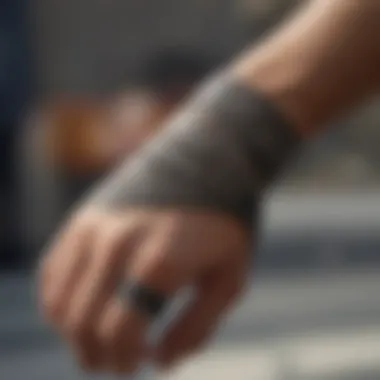Exploring the Fascinating World of Coordinating Wrist Bands


Skateboarding News Updates
Matching wrist bands have become a prevalent trend within the skateboarding community, adding a unique flair to skaters' outfits while also symbolizing camaraderie and unity. Whether worn to showcase team spirit during competitions or simply as a fashion statement, these bands have garnered widespread popularity among skateboarders of all levels. With various styles and designs available, from bold colors to intricate patterns, matching wrist bands have transcended their utilitarian purpose to become a statement piece in the skateboarding culture.
Gear Reviews and Recommendations
When considering the best matching wrist bands for your skateboarding ensemble, it's essential to focus on durability, comfort, and aesthetics. Opting for bands made from high-quality materials ensures longevity, especially during intense skate sessions where wear and tear are inevitable. Comfort is equally crucial, as skaters require freedom of movement without any restrictions from their accessories. Additionally, selecting bands that complement your personal style and overall outfit can elevate your look while reflecting your individuality within the skateboarding community. Stay tuned for insightful reviews and recommendations on the top matching wrist bands to enhance your skateboarding gear lineup.
Healthy Lifestyle for Skaters
Incorporating matching wrist bands into your skateboarding lifestyle goes beyond mere fashion; it can also serve as a constant reminder of the importance of maintaining a healthy lifestyle. Engaging in injury prevention exercises not only protects your body from common skateboarding-related injuries but also enhances your overall performance on the board. Furthermore, integrating skateboard fitness and strength training regimens can improve your agility, stamina, and finesse, crucial elements for mastering advanced tricks and maneuvers. Pairing this physical training with nutritious eating habits tailored to skaters' energy and nutritional needs completes the holistic approach to a healthy lifestyle within the skateboarding community.
Introduction
In the realm of fashion and self-expression, an intriguing trend that has gained traction in recent times is the culture of matching wrist bands. This article embarks on a journey to unravel the mysteries and nuances surrounding this unique trend, offering a comprehensive exploration of its significance, popularity, and the diverse array of styles it encompasses. By delving into the cultural roots and delving into the fashion statements under its wing, this piece aspires to provide a detailed companion for enthusiasts and trendsetters hungry for insightful perspectives in the realm of wrist band coordination.
Defining Matching Wrist Bands
When we talk about defining matching wrist bands, we are essentially referring to a set of wrist bands or bracelets worn together to complement each other. These bands are intentionally chosen to create a harmonious visual appeal, whether through color coordination, material cohesion, or thematic unity. Matching wrist bands serve as a form of self-expression, allowing individuals to showcase their personality, preferences, and sometimes even their affiliations through a curated selection of wrist adornments.


Brief History of Wrist Bands
Venturing into the annals of history, wrist bands have adorned the wrists of various civilizations for centuries. From ancient Rome to indigenous tribes, wrist bands have served purposes that go beyond mere aesthetics. Historically, wrist bands were used to signify social status, ward off evil spirits, or even as symbols of allegiance during wars. The evolution of wrist bands from functional to fashionable accessories parallels the evolution of human societies and their values, reflecting the changing dynamics of culture and style over time.
Purpose of Wearing Matching Wrist Bands
The act of wearing matching wrist bands transcends mere fashion statements; it embodies an array of purposes and intentions. For some, it is a gesture of solidarity and unity, symbolizing shared experiences or relationships. Others may use matching wrist bands as a form of self-identification or a nod to a specific cause or belief. Additionally, wearing matching wrist bands can serve as a subtle yet impactful way to accessorize an outfit, adding layers of depth and sophistication to one's overall look. Whether for aesthetics, symbolism, or personal connection, the purpose behind wearing matching wrist bands is as diverse as the wearers themselves.
Cultural Significance
Matching wrist bands hold a profound cultural significance that transcends mere fashion accessories. These wrist bands symbolize unity, connection, and a sense of belonging within different cultural contexts. The wearing of matching wrist bands is not merely a trend but a practice deeply rooted in traditions and customs across various societies. The cultural significance of wrist bands can be traced back to ancient civilizations where they were used to signify belonging to a specific group, tribe, or social class.
Symbolism in Different Cultures
In different cultures, wrist bands carry diverse symbolism. For example, in some cultures, matching wrist bands are exchanged as symbols of friendship or love, reinforcing the bond between individuals. In contrast, certain cultures use wrist bands as talismans for protection or good luck. The variety of symbolic meanings attached to wrist bands reflects the rich tapestry of cultural beliefs and practices worldwide.
Historical Meanings of Wrist Bands
The historical meanings of wrist bands date back centuries, with evidence of their use in ancient Egypt, Rome, and other civilizations. These bands served not only as decorative ornaments but also as identifiers of social status, allegiance, or affiliation. Over time, wrist bands evolved to represent milestones, achievements, or commemorations, reflecting the changing customs and values of societies throughout history.
Modern Interpretations


In contemporary society, the modern interpretation of wrist bands has expanded beyond traditional roles. Wrist bands are now seen as fashion statements, expressions of personal identity, and even statements of solidarity with social causes. The modern wearer of wrist bands may choose designs that align with their values, hobbies, or affiliations, using them as a form of self-expression and communication. The evolution of wrist band meanings mirrors the evolving complexities of culture and identity in the modern world.
Popularity and Trends
In the ever-evolving landscape of fashion and culture, the realm of wrist bands has seen a significant rise in popularity and an intriguing shift in trends. Matching wrist bands have transcended mere accessories to become potent symbols of unity and style in various subcultures. The importance of examining the topic of Popularity and Trends lies in dissecting the sociocultural relevance and individual expressions encapsulated within these seemingly simple adornments. By exploring the specific elements that propel wrist bands into the forefront of contemporary fashion, enthusiasts gain a deeper appreciation for the artistry and symbolism embedded in these accessories.
Influential Figures Sporting Matching Wrist Bands
An insightful aspect that elevates the allure of matching wrist bands is the impactful role played by influential figures across different domains. These figures, ranging from renowned musicians and athletes to social media personalities, serve as trendsetters who shape the narrative surrounding wrist band styles. By observing how these influential individuals incorporate wrist bands into their everyday attire, enthusiasts glean inspiration and perspective on the versatility of these accessories. Analyzing the fashion choices of these figures allows enthusiasts to understand the nuances of wrist band coordination and the statement-making potential that these seemingly minor details hold.
Evolution of Wrist Band Styles
The journey of wrist band styles unfolds as a fascinating narrative of innovation and creativity within the fashion world. Over time, wrist bands have undergone a metamorphosis, mirroring the societal shifts and design preferences of each era. From the simplicity of basic bands to the complexity of layered and textured designs, the evolution of wrist band styles showcases the continuous reinvention and reinterpretation of this classic accessory. Understanding the evolution of wrist band styles provides enthusiasts with a historical context that enriches their appreciation for the diverse options available in today's market.
Social Media Impact on Wrist Band Culture
In the age of digital connectivity, social media platforms wield a significant influence on shaping fashion trends and cultural phenomena. The impact of social media on wrist band culture manifests in the way enthusiasts discover, share, and engage with various wrist band styles and brands. Platforms like Instagram and Twitter serve as virtual runways where individuals showcase their personalized wrist band pairings, fueling a sense of community and creativity within the wrist band culture. The analysis of social media's impact on wrist band culture sheds light on how these platforms act as catalysts for trend propagation and style inspiration in the contemporary fashion landscape.
Fashion Statements
Matching wrist bands are not only functional but also serve as powerful fashion statements in contemporary culture. The significance of wrist bands in the realm of fashion lies in their ability to convey personal style, beliefs, and affiliations without uttering a word. These accessories have transcended their utilitarian roots to become symbols of identity and unity. When curated thoughtfully, wrist bands can communicate a message or evoke an emotion, making them versatile pieces in any individual's wardrobe. Whether stacked in layers or worn alone, wrist bands have the power to elevate an outfit from mundane to meaningful.


Coordination and Pairing of Wrist Bands
Albeit small in size, wrist bands play a pivotal role in crafting a cohesive look. The art of coordinating and pairing wrist bands involves selecting pieces that complement each other in terms of color, texture, and design. A harmonious blend of wrist bands set against one's skin tone or outfit can enhance the overall aesthetic appeal. Whether opting for a monochromatic scheme for a minimalist look or mixing contrasting colors to make a bold statement, understanding how different wrist bands interact with each other is essential for creating a balanced ensemble.
Mixing Materials and Textures
The allure of wrist bands lies not only in their visual appeal but also in the tactile experience they offer. Mixing materials and textures when adorning wrist bands can add depth and dimension to an outfit. Combining leather with metal accents, beads with woven threads, or silicone with charms can create intriguing contrasts that draw the eye. The choice of materials and textures allows individuals to express their personality and experiment with diverse styles, elevating their fashion repertoire beyond traditional norms.
Impact of Wrist Bands on Overall Outfits
Despite their modest size, wrist bands wield significant influence over the overall aesthetic of an ensemble. A carefully curated selection of wrist bands can act as focal points, tying together different elements of an outfit seamlessly. Whether aiming for a casual, sporty look with rubber wrist bands or a sophisticated, formal appearance with leather bands, the impact of wrist bands on overall outfits is undeniable. By paying attention to details such as color coordination, layering, and sizing, individuals can leverage wrist bands to make a pronounced statement in their fashion choices.
Practical Uses
In this section, we will delve into the practical applications of wristbands, shedding light on their versatile uses beyond just fashion. Matching wristbands are not only stylish accessories but also serve functional purposes in various aspects of daily life. From sports and fitness enthusiasts to individuals in need of identification, these bands offer a wide array of benefits. One key element of practical use is their durability and flexibility, allowing them to withstand rigorous physical activities without losing their form or functionality. Moreover, their lightweight nature ensures maximum comfort, making them ideal for prolonged wear. When considering practical uses, it is essential to take into account the material and design of the wristbands, as these factors play a crucial role in determining their suitability for different purposes.
Sports and Fitness Applications
When it comes to sports and fitness, matching wristbands play a pivotal role in enhancing performance and style. Athletes often rely on wristbands to wipe off sweat during intense workouts, maintaining a firm grip on equipment, and even serving as a fashion statement. The moisture-wicking properties of these bands help keep the wearer dry and comfortable during strenuous physical activities, while the snug fit provides added support to the wrist joints. Furthermore, the vibrant colors and designs of sports wristbands not only reflect personal style but also contribute to team camaraderie and unity.
Identification and Access Control
In settings where identification and access control are paramount, wristbands offer a convenient and efficient solution. Whether at events, workplaces, or public venues, these bands serve as visible markers of authorization, restricting entry to designated areas or granting specific privileges. The use of RFID technology in modern wristbands allows for seamless access control, enabling quick and secure identification of individuals. Additionally, customizable options such as barcode integration and personalized information enhance the utility of these wristbands for identification purposes, ensuring smooth operations and enhanced security.
Medical Alert Wrist Bands
Medical alert wristbands are instrumental in communicating vital health information in cases of emergencies or medical situations. These bands, often adorned with medical symbols or specific medical conditions, serve as immediate identifiers for first responders, alerting them to crucial details about the wearer's medical history or requirements. The use of color-coded bands or engraved information enhances the visibility and accessibility of vital information, ensuring swift and accurate response in times of need. Overall, medical alert wristbands serve as essential tools in promoting health awareness and ensuring timely intervention when faced with medical emergencies.







